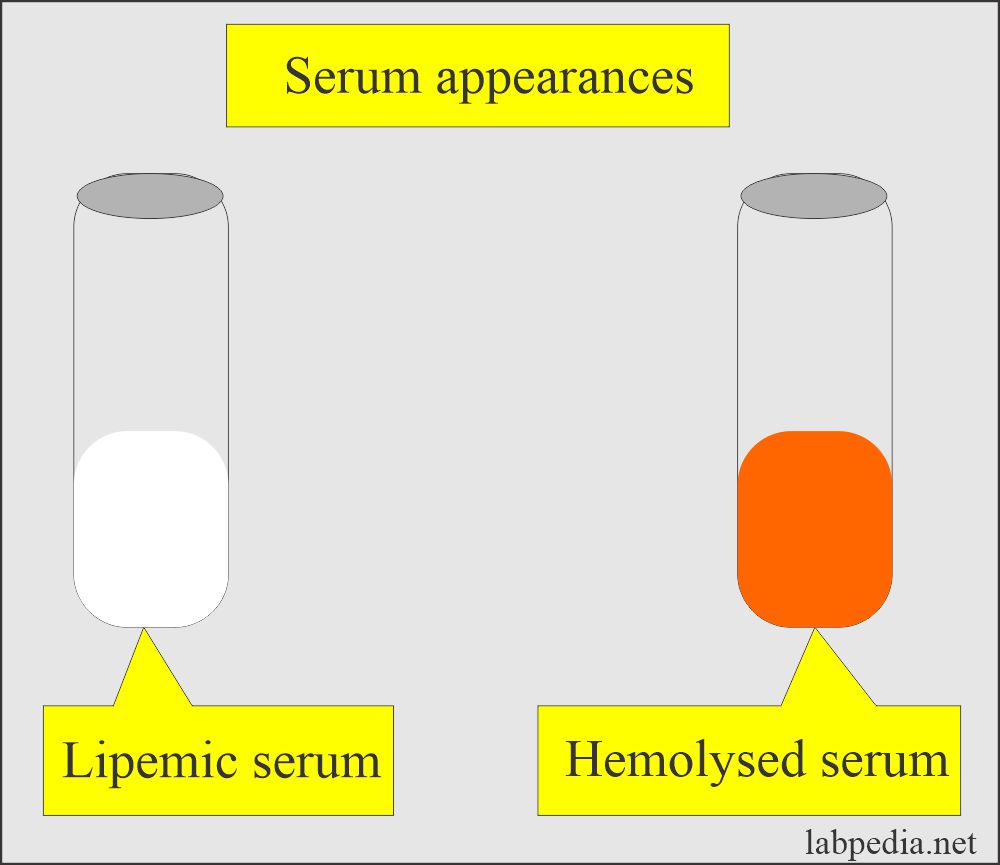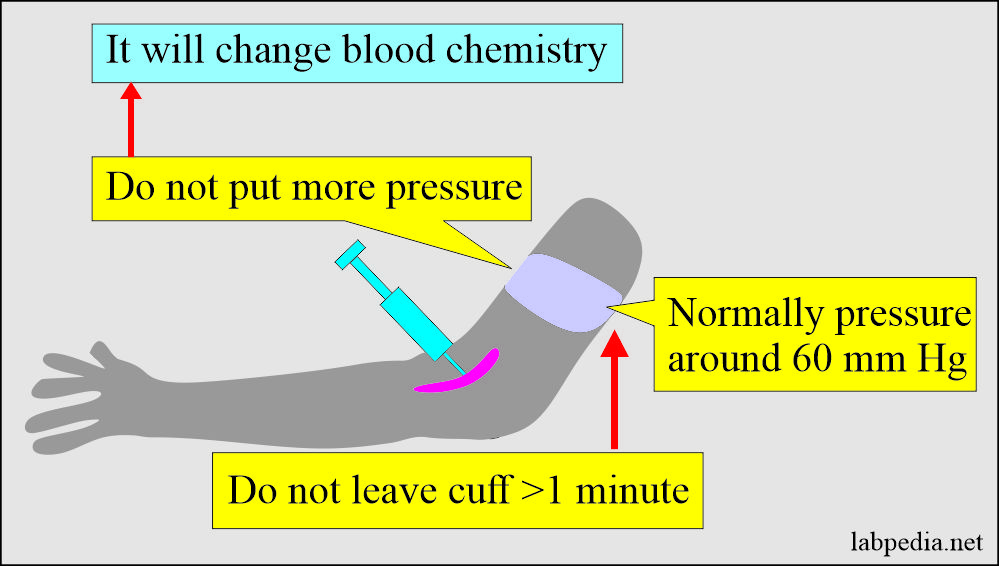Blood samples That should be Discarded, and Effect of Pressure While Collecting the Blood
Blood samples that should be discarded (Rejected)
- Whenever you find the following possibilities, reject the sample, and try to get another fresh sample.
Blood samples That should be Discarded
Hemolyzed sample:
- Serum shows evidence of hemolysis when the hemoglobin is >20 G/dL.
- Slight hemolysis does not affect most of the test values.
- Severe hemolysis causes a dilutional effect on those constituents, with a lower concentration in the RBCs than the plasma.
- There will be a marked effect of those parameters present in high RBC concentrations than in the plasma.
- Hemolysis will increase the value of:
- Aldolase.
- Lactate dehydrogenase (LDH).
- Total acid phosphatase.
- Magnesium.
- Potassium.
- Phosphate.
- Evidence of hemolysis:
- Serum haptoglobin is <6 mg/dL.
- Increased serum potassium (K+).
- Increased acid phosphatase and prostatic acid phosphatase.
- Increased cholesterol
How to prevent hemolysis:
-
- Make sure that the syringe and the needles are dry.
- Plastic disposable syringes are preferred.
- Avoid rough handling of the blood. Handle carefully and gently the blood sample.
- Remove the needle and then eject the blood into the tube. Blood through the needle will leads to hemolysis.
- Mix the anticoagulant gently and try to b not rough.
- Gently transfer the blood and avoid frothing of the blood sample.
- Before taking blood, be sure that the skin is dry.
- If you apply sterile petroleum on the heel, it will avoid the spreading of the blood.
- Collection of the heel prick blood, when collected in a heparinized plastic tube or a siliconized glass tube, will prevent hemolysis.
- In case of delay (1 to 3 hours), store the blood in the fridge at 4 °C to 10 °C.
- If there is the possibility of cold agglutinins, store the blood at 37 °C in a water bath.
- Avoid freezing of blood because, on thawing, RBCs will lead to hemolysis.
- Hypotonic solutions will hemolyze the blood, so try to prepare the isotonic solution.
Lipemic serum:
- Serums with lipemic appearance will affect chemistry tests like:
- Phosphorus.
- Creatinine.
- Total protein.
- Calcium.
- ALT (Alanine aminotransferase).
- Ultracentrifugation can remove the effect of lipemia.
- Lipemia leads to:
- Decreased sodium (Hyponatremia).
- Decreased potassium (Hypokalemia).
- Increased chloride (Hyperchloremia).
Blood Samples to be rejected:
- The sample for CBC is unsuitable if there are clots and it is hemolyzed.
- If there are microclots are not suitable for Cell counting, it will give a low count.
- If there is an insufficient blood sample.
- If the sample is not labeled.
- If there is a discrepancy between the sample and the request form.
- If the blood sample is insufficient in quantity.
- Poor handling of the sample when there is the effect of light.
- The sample was collected at the wrong time.
- If there is contamination of the sample.
Changes in the blood/serum when the vein is pressurized too much:
- Most of the time, the tourniquet puts pressure on the vein to make it prominent.
- When a blood pressure cuff is used, the pressure is mostly ∼60 mm Hg.
- Never leave the velcro pressure cuff for more than one minute; it will change the blood chemistry even with a shorter period of time.
If the cuff is applied for 1 to 3 minutes, it will lead to blood chemistry changes:
| Parameters | Increase in concentration | Decrease in concentration |
| Potassium | 6.2% | |
| Bilirubin | 8.4% | |
| Cholesterol | 5.1% | |
| Total lipid | 4.7% | |
| Total protein | 4.9% | |
| AST (SGOT) | 9.3% | |
| Iron | 6.7% |
Blood sample’s importance:
- The blood sample near the tourniquet has the same composition as the circulating blood.
- So use the first sample for the critical values like serum calcium.
- The first tube may show a 5% increase in the protein level, while the third tube shows a 10% change.
- In the case of slight trauma to the skin may increase the enzymes (SGOT).
- In the case of stress, the patient will increase the growth hormone and cortisol.
Questions and answers:
Question 1: What is the effect of lipemia on sodium?
Question 2: What is the best test to find hemolysis evidence?


